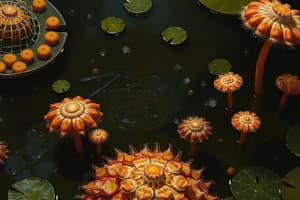Podcast
Questions and Answers
What characteristic distinguishes protists from bacteria?
What characteristic distinguishes protists from bacteria?
- Ability to move
- Reproduction by spores
- Presence of a nucleus (correct)
- Uniqueness to aquatic environments
Which of the following categories do protozoans belong to?
Which of the following categories do protozoans belong to?
- Animal-like protists (correct)
- Plant-like protists
- Decomposers
- Fungal-like organisms
What method of movement do sarcodines primarily use?
What method of movement do sarcodines primarily use?
- Pseudopodia (correct)
- Flagella
- Cilia
- Spore formation
What best describes sporozoans?
What best describes sporozoans?
Which protozoan utilizes flagella for movement?
Which protozoan utilizes flagella for movement?
Which of the following statements about autotrophic protists is accurate?
Which of the following statements about autotrophic protists is accurate?
What type of organism is Plasmodium, known for causing malaria?
What type of organism is Plasmodium, known for causing malaria?
Which term refers to the group of protozoans that move using tiny hair-like projections?
Which term refers to the group of protozoans that move using tiny hair-like projections?
Study Notes
Prokaryotes vs Eukaryotes
- Prokaryotic cells lack a nucleus and membrane-bound organelles.
Protists
- Mostly unicellular eukaryotic organisms.
- Not classified as plants or animals.
- Four "Supergroups".
Types of Protists
- Heterotrophs (animal-like)
- Autotrophs (plant-like)
- Decomposers (fungus-like)
Protozoans (animal-like)
- Unicellular
- Eukaryotic
- Heterotrophs
- Move using various methods.
Sarcodines
- Move using extensions of cytoplasm called pseudopods.
- Example: Amoeba.
Zooflagellates
- Move using whip-like extensions called flagella.
- Examples: Trichonympha (digests cellulose in termites), Trypanosoma (causes African Sleeping Sickness).
Ciliates
- Largest group of protozoans.
- Covered in tiny hair-like projections called cilia.
- Example: Paramecium.
Sporozoans
- Non-motile, spore-forming, parasitic protozoans.
- Reproduce sexually and asexually.
- Plasmodium (causes malaria), is a parasitic protozoan that spreads through fluid.
- Immature sporozoans are called sporozoites.
Studying That Suits You
Use AI to generate personalized quizzes and flashcards to suit your learning preferences.
Related Documents
Description
Explore the fascinating world of cells with this quiz on prokaryotes and eukaryotic organisms, specifically focusing on protists. Learn about the characteristics, types, and unique features of protozoans and their classifications. This quiz will test your knowledge on these essential biological concepts.




